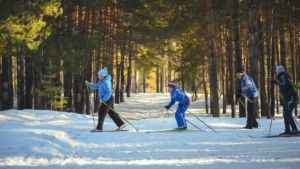Over ten million Americans experience Seasonal Affective Disorder (SAD) every year. You might also know this condition as “the winter blues.” It tends to peak in January and February, but many people start feeling down in October or November when days begin to shorten, and the weather starts turning cold. SAD is defined as a type of depression that occurs only during the fall and winter months. The symptoms are similar to other types of depression and can include sleeping too much or too little, fatigue, lack of motivation, and even hopelessness or suicidal thoughts.
There are many effective treatments for SAD and even some preventative actions that you can take before symptoms begin to impact your daily life. Here are five things you can do to lift your mood this winter:
1. Get Your Daily Dose of Sunshine
Studies indicate that less exposure to sunlight during winter months may disrupt melatonin and serotonin production in some people. Sunshine can be hard to come by in far northern climates, but taking a walk outside early in the day can improve symptoms and regulate sleeping patterns in people prone to seasonal depression. Even during a cloudy day, you will get some UV rays. Fifteen to thirty minutes of outside activity within the first two hours of waking up, or as soon as it’s sunny, are recommended.
For those who live in places where the sun barely shines at all or where weather conditions prevent outside activity, lightboxes can be helpful. Lightboxes produce light that mimics sunlight. When used for about thirty minutes every morning during the fall and winter months, light therapy has been shown to significantly improve seasonal depression symptoms. Ask your doctor about light therapy and let them know if you have a personal or family history of bipolar symptoms.
2. Eat Your Sunshine
Vitamin D, also known as the “sunshine vitamin,” is vital for emotional health, bone health, and your immune system. Many people who live in temperate climates are deficient in vitamin D and can benefit from supplementation. The amount of vitamin D needed to help with SAD symptoms depends on the person and the level of deficiency. If you think you may be deficient but haven’t had a blood test to determine your vitamin D levels, 400 to 800 IU’s per day is the recommended starting dose. A simple blood test can let you know if you need more. Some people are extremely deficient and may require Vitamin D injections or a high oral Vitamin D supplementation dose. Your doctor or natural health practitioner can help you find the right dosage.
Fish oil is one of the few foods that contains Vitamin D (in small doses). The fatty acids in fish oil are also thought to have a protective effect on the nervous system and have been found to decrease inflammation. Many people with SAD can benefit from taking both Vitamin D and fish oil, especially during the fall and winter months. Fish oil is safe for most people, but you should check with your health care provider before taking it if you also take other medications such as blood thinners. Adding more fish to your diet can also improve neurological and cardiovascular health.
3. Stay Active
Decreased activity levels are often a symptom of seasonal depression. Even when you don’t feel like doing much, a short work out, yoga routine, or walk can lift your mood. Take advantage of days when you feel better and try to be active for 30 minutes or more. Exercise reduces stress and increases serotonin levels. Among people with all kinds of depression, including SAD, regular exercise has proven to be as effective as antidepressant drugs in reducing symptoms and improving the overall quality of life. Your physical health will also benefit.
Some scientists think that a sedentary lifestyle can make a person more prone to depression. Depression then makes it harder to be active, causing a vicious cycle. Forcing yourself to get more physical activity can help break this cycle and may prevent future depressive episodes.
4. Seek Help
SAD is often regarded as a mild form of depression that doesn’t warrant therapy or medication, but many people experience symptoms that interfere with everyday life. If you feel that your winter blues is disrupting your work or social life or wreaking havoc on your sleep schedule, therapy could help. Look for a therapist who is trained in CBT therapy for SAD. This kind of therapy is extremely effective in helping people to overcome and prevent depressive symptoms. If you feel hopeless, don’t hesitate to dial the national suicide hotline, 1-800-273-8255. (This number is helpfully being changed to 9-8-8 as of July 2022).
Alternative medicine such as chiropractic adjustment and herbal treatments can also help with seasonal depression. Chiropractic adjustment can help to balance your nervous system and get rid of aches and pains that may be making you feel worse. The herb St. Johns Wort has proven just as effective as many medications for mild to moderate depression. Talk to your chiropractor or alternative health care provider about your symptoms, they may recommend alternative treatments in addition to therapy, nutritional supplementation or light therapy.
5. Adjust Your Expectations
Sometimes symptoms of SAD are aggravated by a negative feeling or expectation about the winter months. Many people dread winter and spend three months thinking longingly of sun-soaked days on the beach. In Denmark, a land of long, dark winters, they embrace the concept of Hygge. Hygge is the idea of purposefully slowing down in the wintertime and enjoying the coziness that the season can bring. Interestingly, Danes have a low incidence of SAD, and some researchers think Hygge helps them avoid it.
Simplifying your holiday plans and making time for enjoyable indoor activities like reading or playing a game with family can help SAD sufferers feel better. If you can find things to enjoy during the winter, this can lead to less dread of the season and fewer depressive feelings the next year.
In Denmark, Hygge is a social concept. Finding ways to be social when the roads are bad can be hard, but making time to spend with friends and family is beneficial for everyone’s mental health. During the ongoing pandemic this winter, using technology like video calling can help you feel connected and in better spirits.







